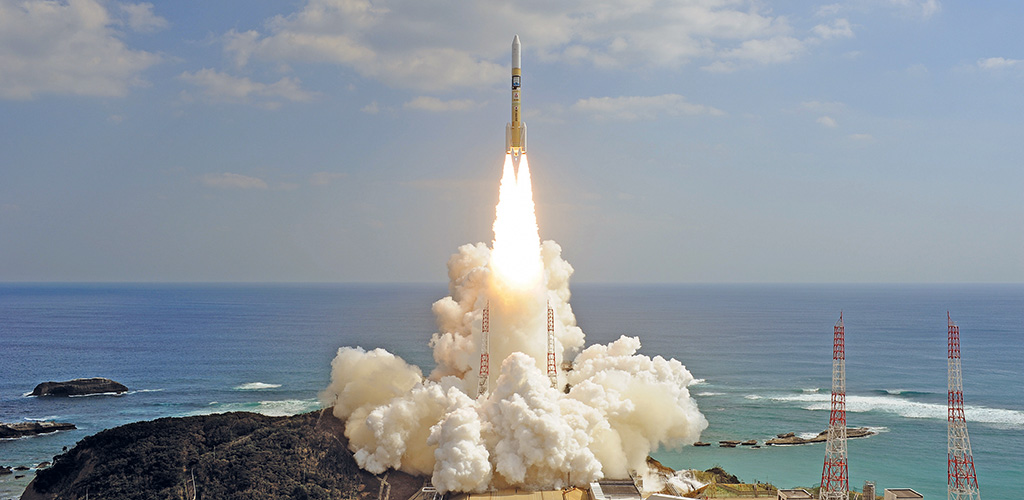Nov 03 | 2020
Emirati Mission Conquers Pandemic-related Hurdles

 By Paul Scott Abbott
By Paul Scott AbbottBefore embarking on a 306-million-mile (492-million-kilometer), 200-day trek to Martian orbit, 30 tonnes of spacecraft and associated equipment had to complete journeys by air, land and sea from Colorado to Dubai to a remote Japanese island launch site – a process intensified by a pandemic-impacted Earth.
Between February and April, the Hope orbiter craft – the centerpiece of the United Arab Emirates Space Agency’s Emirates Mars Mission – traversed the globe along with related spacebound cargo on flights totaling nearly 13,000 miles (21,000 kilometers) in addition to moves by road and water.
“The realization that we had to run against the Covid clock was where things got complicated,” Omar Al Shehhi, assembly, integration and testing lead for the UAE agency’s Emirates Mars Mission, told Breakbulk.
Adjustments to initial plans, Al Shehhi said, were necessary to meet the narrow July 2020 launch window – related to the once-every-two-years ideal alignment of Earth and Mars – so as to have the uncrewed Hope orbiter circling Mars before the 50-year anniversary in December 2021 of the independence of the United Arab Emirates.
Of course, when UAE leaders announced the intended mission in 2014, they could not have predicted that Earth would be grappling with a global health crisis in the year of the launch. What they did already know was that having all the equipment in place for liftoff was complex anyway, as the highly sensitive spacecraft was to be fabricated in the western U.S. and undergo preparations in the UAE before being launched from Japan’s Tanegashima Space Center.
Process Intensifies
“The transport process of spacecraft in general is very complicated because of the nature of the craft and its instruments and their sensitivity to temperature, humidity, dust and movement,” Al Shehhi said. “What was supposed to be routine turned out to be mission-critical.
“With added issues triggered by the Covid-19 pandemic, the team plan to manage the process had to be doubled, tag-teaming with quarantine requirements necessitating team members be in place for 14 days,” he continued. “As a result, the launch team had to travel three weeks earlier than the aircraft – several weeks before the probe’s scheduled transfer date.”
Al Shehhi, a former Emirates Airlines avionics engineer, was among eight Emirati space engineers who were in place in Japan earlier than originally scheduled and who kept daily logs of their temperatures as part of efforts to ensure safety of themselves and the launch site. Plans to bring along some of the engineers’ children to enjoy the liftoff had to be shelved due to pandemic concerns.
True to original plans, an Antonov AN-124 heavy-lift cargo aircraft, operated by Ulyanovsk, Russia-based Volga-Dnepr Airlines, was used for the longest legs of the spacecraft’s earthly travels.
After assembly and completion of environmental and shock tests and other preparations at the Laboratory for Atmospheric and Space Physics at the University of Colorado Boulder, a shipment of five units with a total weight of 30 tonnes was ready Feb. 8 for the 21-hour flight to the UAE, including a fueling stopover at Keflavik, Iceland.
‘Mobile Cleanroom’
While some of the cargo flew in standard 20-foot-long shipping containers, the sensitive Hope probe – also known as the EMM Observatory – was enveloped in specialty packaging, according to Brian Pramann, Emirates Mars Mission assembly integration and test manager at the University of Colorado facility. (Other U.S. entities engaged in the endeavor have included Arizona State University and the University of California, Berkeley.)
“The container was essentially a mobile cleanroom with custom temperature and humidity control, active particulate and nonvolatile air filtration, continuous gaseous nitrogen purging, shock isolation, and active temperature, humidity and acceleration monitoring equipment,” Pramann said.
All satellite and associated equipment was lifted via mobile boom crane onto open-bed, extra-wide trucking equipment for the 43-mile (69-kilometer) over-the-road trip to Denver International Airport. There the cargo was loaded onto a Volga-Dnepr AN-124 plane for the 7,900-mile (12,714-kilometer) flight to Al Maktoum International Airport, south of Dubai, and moved 42 miles (68 kilometers) by specialized truck to Mohammed bin Rashid Space Center in Dubai.
Following two months of further testing and preparations at the UAE space center, the spacecraft was ready for another flight, this time for a journey of some 5,000 miles (8,047 kilometers) to Chubu Centrair International Airport, on an artificial island south of Nagoya, in central Japan.
Again, according to Al Shehhi, the Hope probe took flight within “a miniature portable cleanroom,” with both temperature and humidity kept within a fixed range and a nitrogen purge system protecting delicate instruments from dust. Other mechanical and electrical equipment shipped with the Hope craft included ground handling and operations systems.
Vibrations Averted
The over-the-road trip to the airport, which would normally take 45 minutes, instead took two hours, Al Shehhi said, with low-speed travel required “to reduce the vibrations generated from bumps in the road.”
The Hope craft and related cargoes once again were loaded onto a Volga-Dnepr AN-124 airplane, accompanied by a team of Emirati engineers monitoring the shipment’s safety. A flight route presenting the least likelihood of turbulence was selected to minimize vibrations that could impact the hypersensitive equipment. The handoff between the Dubai engineers who accompanied the shipment and the team that had gone ahead to Japan was accomplished without face-to-face contact to reduce the chance of Covid-19 infection spread.
Finally, a team led by Al Shehhi oversaw the unloading of the cargo from the aircraft, its short transport to the island airport’s quay, its 44-hour trip by sea freighter to Shimama Port on Tanegashima Island in far southern Japan and its 12-mile (19-kilometer) over-the-road move to Tanegashima Space Center, run by the Japan Aerospace Exploration Agency, or JAXA. The team waited until nightfall for that last little leg “to travel along quieter roads,” Al Shehhi said.
Overall, the trip from the UAE space center to the Japanese launch site spanned 83 working hours from April 20 to 24, according to Al Shehhi.
On July 19, the Hope probe, perched atop a two-stage Mitsubishi H2A launch platform, lifted off from the Japanese space center, carrying Arab world aspirations and scientific experiments for studying the Martian atmosphere throughout two years of planned orbit around the Red Planet, which it is on target to reach in February, well ahead of the Dec. 2 celebration of the half-century anniversary of the establishment of the independent United Arab Emirates.
A professional journalist for nearly 50 years, U.S.-based Paul Scott Abbott has focused on transportation topics since the late 1980s.
Image credit: United Arab Emirates Space Agency


